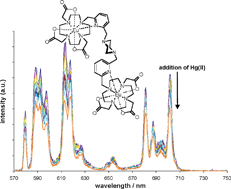Responsive, di-metallic lanthanide complexes of a piperazine-bridged bis-macrocyclic ligand: modulation of visible luminescence and proton relaxivity†
Abstract
The synthesis of a new functionalised bis-macrocyclic ligand (L1) is described together with the corresponding


 Please wait while we load your content...
Please wait while we load your content...